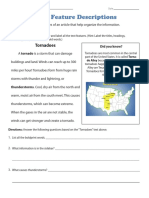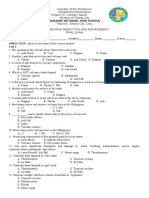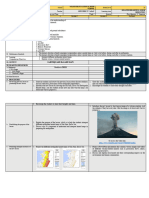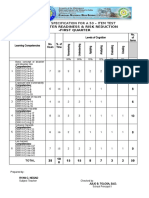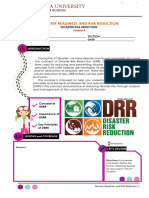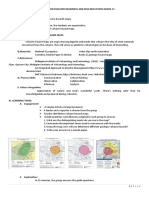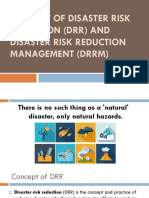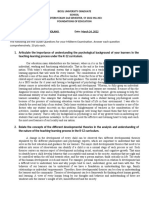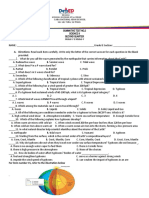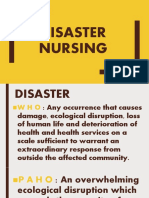DRRR 1st Summ Exam PDF Free
DRRR 1st Summ Exam PDF Free
Uploaded by
Manuel Paulo AcogidoCopyright:
Available Formats
DRRR 1st Summ Exam PDF Free
DRRR 1st Summ Exam PDF Free
Uploaded by
Manuel Paulo AcogidoOriginal Title
Copyright
Available Formats
Share this document
Did you find this document useful?
Is this content inappropriate?
Copyright:
Available Formats
DRRR 1st Summ Exam PDF Free
DRRR 1st Summ Exam PDF Free
Uploaded by
Manuel Paulo AcogidoCopyright:
Available Formats
SUMMATIVE EXAMINATION IN D.R.R.R.
NAME: GRADE/SECTION:
FIRST SUMMATIVE EXAM IN DRRR
DIRECTIONS: This test is a combination of single response and multiple-choice test, thus there could only be one answer for
a single response items and two or more answers for a multiple-choice item. Read each item carefully and respond by
choosing the correct answer/s. Write your answers on your answer sheet.
1. is a dangerous phenomenon, substance, human activity or condition that may cause loss of life, injury or other health
impacts, property damage, loss of livelihood & services, social & economic disruption or environmental damage
a. disaster b. hazard c. risk d. exposure
2. is the combination of all strengths and resources available within the community, society or organization that can
reduce the level of risk or effects of a disaster.
a. Vulnerability b. Risk c. exposure d. capacity
3. Which of the following is NOT a variable/ factor that aggravates or mitigates the effects of hazards, affecting the degree or scope
of a disaster
a. physical b. socio – cultural c. economic d. self-resiliency
4. Which of the following impact of disaster that disturb social wealth and cohesion, wellbeing and sometimes identity which may also
result to psychological distress, conflicts and other social ills escalate.
a. structural c. Environmental
b. socio-economic d. Physical
5. Which of the following is a combination of probability of an event to happen and its negative consequences
a. vulnerability b. risk c. exposure d. capacity
6. Disasters frequently result in all of the following EXCEPT:
a. Damage to the ecological environment
b. Destruction of a population’s homeland
c. Displacement of populations
d. Sustained public attention during the recovery phase
7. Which of the following is NOT a factor of vulnerability?
a. poverty b. religion
c. physical disability d. mental state
8. Tsunami is an example of which hazard?
a. geological b. hydrometeorological
c. technological d. biological
9. Which of the following is / are example/s of technological hazards?
a. cyber terrorism b. nuclear accidents
c. epidemic diseases d. AIDS
10. Which of the following is not a common long-term impact of hazards
a. psychological b. economic
c. environmental d. technological
11. Disaster is frequently described as a result of various condition except .
a. exposure to hazard
b. conditions of vulnerability at present
c. aving enough physical, social, and attitudinal capabilities
d. insufficient capacity or measures to cope with disasters.
12. Which can't be prevented but can be anticipated generally?
a. human-made hazards b. disasters
c. socio-natural Hazards d. natural hazards
13. Which of the following is / are the hazards from an earthquake?
a. liquefaction b. ground shaking c. fire d. storm surge
14. Earthquake may be caused by which of the following?
a. tectonic b. volcanic eruption c. tsunami d. landslide
15. is a displacement on the ground due to movement of fault
a. around shaking b. ground rupture
c. liquefaction d. grounding
16. During an earthquake, which among the following is / are the safe thing/s to do?
a. Do the “duck, cover and hold” b. Stay calm
c. Secure all your belongings d. Run immediately
17. Which of the natural processes involves the formation of clouds, precipitation, wind, etc.?
a. plate tectonics b. atmospheric processes
c. human activities d. biological accumulation
18. A serious disruption of the functioning of a community or a society involving widespread human, material, economic, or
environmental losses and impacts which exceeds the ability of the affected community or society to cope using its own
resources.
a. disaster b. hazard c. risk d. exposure
19. Process or phenomenon of organic origin or conveyed by biological vectors/ agents, including exposure to
pathogenic microorganisms, toxins and bioactive substances.
a. biological b. geological c. technological d. hydro
20. These are naturally occurring physical phenomena caused either by rapid or slow onset events.
a. man-made hazards b. technological hazards
c. natural hazards d. geological hazards
21-25. Give at least five (5) disaster risk factors.
21.
22.
23.
24.
25.
You might also like
- Earth and Life Science MidtermDocument6 pagesEarth and Life Science MidtermManuel Paulo Acogido100% (2)
- Text Feature Descriptions: TornadoesDocument3 pagesText Feature Descriptions: TornadoesTanjida AhmedNo ratings yet
- Peacespeaker PDFDocument2 pagesPeacespeaker PDFMateus MacNo ratings yet
- Chapter 2 Identifying Specific VulnerabilitesDocument12 pagesChapter 2 Identifying Specific VulnerabilitesallanrnmanalotoNo ratings yet
- Unit 4 Volcanic Hazard Volcano: Cinder Cone VolcanoesDocument5 pagesUnit 4 Volcanic Hazard Volcano: Cinder Cone VolcanoesChristina UyNo ratings yet
- DRRR-Activity 4 - 4th QDocument4 pagesDRRR-Activity 4 - 4th QAshley Jade DomalantaNo ratings yet
- DRRR Chapter Test On DisasterDocument2 pagesDRRR Chapter Test On DisasterVhiinXoii BeriosoNo ratings yet
- DRRR Module 1Document69 pagesDRRR Module 1Joveliezel Jaducana Baroro RodriguezNo ratings yet
- DLP 14Document2 pagesDLP 14zessicrel mejiasNo ratings yet
- 9 Concept of Disaster Risk Reduction (DRR) and Disaster Risk Reduction and Management (DRRM)Document18 pages9 Concept of Disaster Risk Reduction (DRR) and Disaster Risk Reduction and Management (DRRM)Jerik Christoffer Ordinario GasparNo ratings yet
- Name: - Section: - Date: - ScoreDocument4 pagesName: - Section: - Date: - ScoreBRENDEL SACARISNo ratings yet
- DRRR Q1 Module 6Document27 pagesDRRR Q1 Module 6kristanhalili12No ratings yet
- DRRR Worksheet - drr.1Document2 pagesDRRR Worksheet - drr.1Mina Caragan Carreon100% (1)
- PLP DRRR Q1 WK5 Day1Document2 pagesPLP DRRR Q1 WK5 Day1Leovil E. InteNo ratings yet
- Lesson 3 Basic Concept of HazardDocument37 pagesLesson 3 Basic Concept of HazardNikki San Gabriel100% (1)
- Work ImmersionDocument16 pagesWork ImmersionLou BaldomarNo ratings yet
- 3 Basic Concept of HazardDocument43 pages3 Basic Concept of HazardJezrael SaetNo ratings yet
- Curriculum Map (DRRR)Document8 pagesCurriculum Map (DRRR)Juvilyn FelipeNo ratings yet
- Hydrometeorological HazardsDocument26 pagesHydrometeorological HazardsMr GameplayNo ratings yet
- 11 Disaster Readines and Risk ReductionDocument2 pages11 Disaster Readines and Risk ReductionDonaLd 쥍킿쨨곽No ratings yet
- SDO Las Piñas DRRR Q1 M2 Effects of Disaster June 29Document20 pagesSDO Las Piñas DRRR Q1 M2 Effects of Disaster June 29Nillos EliNo ratings yet
- Detailed Lesson Plan For DRRR April 08, 2022Document5 pagesDetailed Lesson Plan For DRRR April 08, 2022allan torreonNo ratings yet
- DRR Lesson 2Document23 pagesDRR Lesson 2Diana Hernandez100% (1)
- 021daily Lesson Log: School: Oslob National National High School Grade Level: GRADE 12Document7 pages021daily Lesson Log: School: Oslob National National High School Grade Level: GRADE 12Hazel GumaponNo ratings yet
- DRRR PerformanceTask ThirdQuarterDocument14 pagesDRRR PerformanceTask ThirdQuarterNayeon IeeNo ratings yet
- 3 Basic Concept of HazardDocument26 pages3 Basic Concept of HazardAndrei Vista BatallaNo ratings yet
- Module - 11 What Expect Between The Sate and The CitizenDocument69 pagesModule - 11 What Expect Between The Sate and The CitizenAnonymous Hitler100% (1)
- DRRR Week 1 - Hand-OutsDocument6 pagesDRRR Week 1 - Hand-OutsRogesa Marie Taboada BatiancilaNo ratings yet
- Teaching Guide For Senior High Schools Disaster Readiness and Risk Reduction (DRRD)Document8 pagesTeaching Guide For Senior High Schools Disaster Readiness and Risk Reduction (DRRD)Ong Eng TekNo ratings yet
- PPPR4Document2 pagesPPPR4Pearl Cabigas0% (1)
- First Quarter Effects of Disasters in One'S Life and Disaster PerspectivesDocument10 pagesFirst Quarter Effects of Disasters in One'S Life and Disaster PerspectivesLloyd FerrerNo ratings yet
- DRRRDocument2 pagesDRRRJoyce Dela Rama JulianoNo ratings yet
- DLL Jeclyn DaissDocument5 pagesDLL Jeclyn DaissJeclyn D. FilipinasNo ratings yet
- Subject Matter Skills and Competencies Code No. of Days Remarks Signature of School HeadDocument4 pagesSubject Matter Skills and Competencies Code No. of Days Remarks Signature of School HeadRhio Cuevas Amor100% (1)
- DRRR Q1 W1 - Mod1Document19 pagesDRRR Q1 W1 - Mod1Julie Ann BautistaNo ratings yet
- DLL DRRR Quarter 1 Week 7Document5 pagesDLL DRRR Quarter 1 Week 7Maria Lourdes PunayNo ratings yet
- On Disaster Readiness & Risk Reduction - First Quarter: Table of Specification For A 50 - Item TestDocument4 pagesOn Disaster Readiness & Risk Reduction - First Quarter: Table of Specification For A 50 - Item TestLiezel CauilanNo ratings yet
- 1 Basic Concept of Disaster and Disaster Risk-2Document27 pages1 Basic Concept of Disaster and Disaster Risk-2John Serrio OdaibmacNo ratings yet
- DRRR - Q1 - Summative Test 4Document8 pagesDRRR - Q1 - Summative Test 4Propsero Luke Godfrey CaberteNo ratings yet
- SLMQ1G11to12DRRM4 v2Document22 pagesSLMQ1G11to12DRRM4 v2Joie OsherNo ratings yet
- Quiz 1 DRRRDocument1 pageQuiz 1 DRRRGail GailNo ratings yet
- Volcanic HazardsDocument10 pagesVolcanic HazardsMa Juliana CambaNo ratings yet
- Potential Earthquake Hazards and Their Effects v2 PDFDocument35 pagesPotential Earthquake Hazards and Their Effects v2 PDFLawrence Cezar100% (1)
- DLL DRRR Quarter 1 Week 5Document5 pagesDLL DRRR Quarter 1 Week 5Maria Lourdes PunayNo ratings yet
- DRRR Q2 M1 Hydrometerological HazardsDocument6 pagesDRRR Q2 M1 Hydrometerological HazardsMs.Muriel MorongNo ratings yet
- Week 1Document3 pagesWeek 1Maricris LacwasanNo ratings yet
- DRRR Q1 Mod4of4-VolcanoRelatedHazards v2Document27 pagesDRRR Q1 Mod4of4-VolcanoRelatedHazards v2Sigua, Havie JeanNo ratings yet
- DRRRDocument3 pagesDRRRJodie CabreraNo ratings yet
- Q4 LESSON 4 (Disaster Risk Reduction)Document8 pagesQ4 LESSON 4 (Disaster Risk Reduction)WhySoSerious?No ratings yet
- Midterm Examination: Disaster Readiness and Risk ReductionDocument3 pagesMidterm Examination: Disaster Readiness and Risk ReductionHarold Nalla Husayan100% (1)
- Exposure and VulnerabilityDocument25 pagesExposure and VulnerabilityShen EugenioNo ratings yet
- Long Quiz in DRRRDocument2 pagesLong Quiz in DRRRLeon PellejaNo ratings yet
- Media and Information SourcesDocument23 pagesMedia and Information SourcesJooyeon ShinNo ratings yet
- DRR11 12 Ih I 25Document3 pagesDRR11 12 Ih I 25Jude TanNo ratings yet
- Culminating Activity: (A Proposal)Document3 pagesCulminating Activity: (A Proposal)Landice Myoui100% (1)
- DRRR Learning Module 2nd QuarterDocument58 pagesDRRR Learning Module 2nd QuarterLANY T. CATAMINNo ratings yet
- Table of Specification Disaster Readiness and Risk Reduction 4th Quarter FINAL EXAMDocument1 pageTable of Specification Disaster Readiness and Risk Reduction 4th Quarter FINAL EXAMRichard CortezNo ratings yet
- Fire Hazards and Related ConceptsDocument21 pagesFire Hazards and Related ConceptsAlyssa Anne CincoNo ratings yet
- DRRRDocument12 pagesDRRRKathleen BrazasNo ratings yet
- Cup Map DRRR '20Document16 pagesCup Map DRRR '20Lany T. CataminNo ratings yet
- UCSPDocument25 pagesUCSPJc TuroNo ratings yet
- drr exam2Document16 pagesdrr exam2AURORA VERGANIONo ratings yet
- disaster risk reduction examDocument6 pagesdisaster risk reduction examAURORA VERGANIONo ratings yet
- 12 GAS E_090852Document1 page12 GAS E_090852Manuel Paulo AcogidoNo ratings yet
- 12 - GAS EDocument6 pages12 - GAS EManuel Paulo AcogidoNo ratings yet
- LETTER OF CONSE-WPS OfficeDocument2 pagesLETTER OF CONSE-WPS OfficeManuel Paulo AcogidoNo ratings yet
- List of Students Albay Agro Industrial Development Corporation ALINDECO CopyDocument2 pagesList of Students Albay Agro Industrial Development Corporation ALINDECO CopyManuel Paulo AcogidoNo ratings yet
- Acogido, Manuel Paulo Midterm FoundationsDocument4 pagesAcogido, Manuel Paulo Midterm FoundationsManuel Paulo AcogidoNo ratings yet
- Reading and Writing No. 4Document2 pagesReading and Writing No. 4Manuel Paulo AcogidoNo ratings yet
- San Miguel National High SchoolDocument5 pagesSan Miguel National High SchoolManuel Paulo AcogidoNo ratings yet
- 2021-SALN-Form - Doc PAUDocument2 pages2021-SALN-Form - Doc PAUManuel Paulo AcogidoNo ratings yet
- Certificate For Recogniton Students (1) PauDocument12 pagesCertificate For Recogniton Students (1) PauManuel Paulo AcogidoNo ratings yet
- DocumentDocument27 pagesDocumentManuel Paulo AcogidoNo ratings yet
- Midterm Exam DRRRDocument2 pagesMidterm Exam DRRRManuel Paulo AcogidoNo ratings yet
- Physical Science Midterm ExamDocument2 pagesPhysical Science Midterm ExamManuel Paulo AcogidoNo ratings yet
- Peer Rating TemplateDocument1 pagePeer Rating TemplateManuel Paulo AcogidoNo ratings yet
- Summative Examination in Earth and Life ScienceDocument2 pagesSummative Examination in Earth and Life ScienceManuel Paulo AcogidoNo ratings yet
- Midterm Exam Mabio213 CMBDocument3 pagesMidterm Exam Mabio213 CMBManuel Paulo AcogidoNo ratings yet
- Full Thesis PDFDocument182 pagesFull Thesis PDFMoshiur RahmanNo ratings yet
- SITIO OTSO ES CP Form 3 - Scenario Generation For Natural HazardDocument2 pagesSITIO OTSO ES CP Form 3 - Scenario Generation For Natural HazardFrederick Dolosa AcostaNo ratings yet
- Coastal Schools Action Research For DepedDocument27 pagesCoastal Schools Action Research For Deped2024files.raybanNo ratings yet
- Flood Drill PlanDocument8 pagesFlood Drill PlanScribdTranslationsNo ratings yet
- Payar-Gomez Conplan TyphoonDocument22 pagesPayar-Gomez Conplan TyphoonZenaida.sorianoNo ratings yet
- Flood Risk Assessment Study of Water Distribution in Cabanatuan CityDocument2 pagesFlood Risk Assessment Study of Water Distribution in Cabanatuan Citychvi.plucena.auNo ratings yet
- Sabelllao Final LPDocument6 pagesSabelllao Final LPapi-712118087No ratings yet
- Reflection NSTPDocument1 pageReflection NSTPMaverick PeteNo ratings yet
- Piece Speech ChoirDocument3 pagesPiece Speech Choirjaspher manaolNo ratings yet
- TételDocument5 pagesTétellsk.dora.kNo ratings yet
- A Big Storm (Descriptive Essay)Document1 pageA Big Storm (Descriptive Essay)leolionsupp0929No ratings yet
- Template For Pre Oral Presentation MelendresDocument14 pagesTemplate For Pre Oral Presentation MelendresValerie MelendresNo ratings yet
- Disaster Preparedness OrientationDocument2 pagesDisaster Preparedness OrientationEmilia Milana CleofasNo ratings yet
- Earthquake Resistant Building RUBRIC ModifiedDocument1 pageEarthquake Resistant Building RUBRIC ModifiedSherlyn Talle100% (1)
- Activity Sheets Disaster (q2 w3-w4)Document2 pagesActivity Sheets Disaster (q2 w3-w4)Jayar DefeoNo ratings yet
- Disasters Around Me: Stella Clarise Pagaran EDocument4 pagesDisasters Around Me: Stella Clarise Pagaran EStella clarise PagaranNo ratings yet
- Persuasive Speech On Disaster ManagementDocument1 pagePersuasive Speech On Disaster ManagementrieLNo ratings yet
- (FREE PDF Sample) How It Works Book of Extreme Weather 2nd Edition Imagine Publishing EbooksDocument53 pages(FREE PDF Sample) How It Works Book of Extreme Weather 2nd Edition Imagine Publishing Ebooksorteaauju100% (7)
- NSTP - Calamity and Disaster PreparednessDocument7 pagesNSTP - Calamity and Disaster PreparednessCarla Marie CortidorNo ratings yet
- Document 19Document2 pagesDocument 19ionmarius20840No ratings yet
- Design: Resilient Homes ChallengeDocument175 pagesDesign: Resilient Homes ChallengePearlNo ratings yet
- Unit-1 Disaster Meaning, Factors and SignificanceDocument11 pagesUnit-1 Disaster Meaning, Factors and Significancevg_mrt0% (1)
- Liquefaction: AGU Civil Eng Dept Int To Earhtquake EngDocument6 pagesLiquefaction: AGU Civil Eng Dept Int To Earhtquake EngYusuf TurgutNo ratings yet
- DISASTER MANAGEMENT Compiled Notes For Unit Lectures: June 2020Document45 pagesDISASTER MANAGEMENT Compiled Notes For Unit Lectures: June 2020Shadab RazaNo ratings yet
- A. Directions: Read Each Item Carefully. Write Only The Letter of The Correct Answer For Each Question in The BlankDocument3 pagesA. Directions: Read Each Item Carefully. Write Only The Letter of The Correct Answer For Each Question in The BlankEmily Tatunay EspejoNo ratings yet
- Q2 WEEK 5 Understanding TyphoonDocument35 pagesQ2 WEEK 5 Understanding TyphoonSHEILA MARIE CORTADO - UNDANNo ratings yet
- DISASTER NURSING ppt1Document239 pagesDISASTER NURSING ppt1ray rais100% (1)
- Practice Test 9 - 1Document9 pagesPractice Test 9 - 1Phuong DaoNo ratings yet

